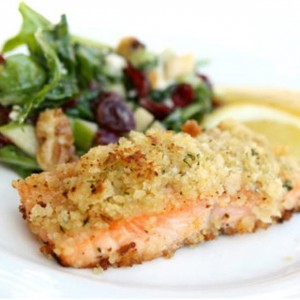Recipe: Encrusted Zesty Salmon Filet
 Ingredients for 10 servings
Ingredients for 10 servings
2-3 lbs salmon filet
2 Tbsps of extra virgin olive oil
Home made bread crumbs (see directions below)
2-3 Zest lemons
white wine (optional)
kosher salt
1 Loaf Ezekiel bread or any other hearty whole grain bread
Preparation
Using your oven’s “Convection Roast” setting
Ever wonder when is the best time to use the “convection roast” setting on your oven? Convection roast is great for meats and fish. If used properly, you can get a nice sear on the outside of your meats, locking the flavorful juices in. In order to do this, increase the temperature of your oven by 100 degrees for the first 20 minutes of the roasting process. This works best when the circulating air inside the oven can hit more of the surface of your meat, so it is best to use a low-sided pan or to elevate the meat on a rack.
Using your oven’s “Convection Bake” setting
Helpful Tip: Don’t be fooled by concealed elements in your oven
Helpful tip:
If your oven has concealed elements, do NOT mistake the bottom of the oven for a shelf on which to put a drip pan or aluminium foil. They will melt to the enamel permanently, which is not only a costly fix, but can also cause the heating elements in the bottom of your oven to short out due to the melted aluminium keeping some of the heat from rising into the oven cavity. Studies also show that aluminium contains chemicals that can be harmful to the human body, so it would be unwise to continue using an oven that has the metal being heated to melting temperatures every time you are baking. The general rule of thumb is never to put anything on the floor of the oven.
